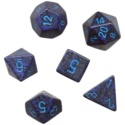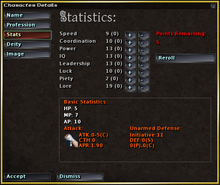
The Generic Universal Role Playing System, or GURPS, is a tabletop role-playing game system published by Steve Jackson Games. The system is designed to run any genre using the same core mechanics. The core rules were first written by Steve Jackson and published in 1986, at a time when most such systems were story- or genre-specific. Since then, four editions have been published. The current line editor is Sean Punch.

The Ringworld science fiction role-playing game was published by Chaosium in 1984, using the Basic Role-Playing system for its rules and Larry Niven's Ringworld novels as a setting.
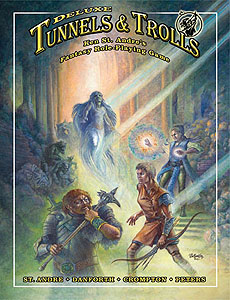
Tunnels & Trolls is a fantasy role-playing game designed by Ken St. Andre and first published in 1975 by Flying Buffalo. The second modern role-playing game published, it was written by Ken St. Andre to be a more accessible alternative to Dungeons & Dragons and is suitable for solitaire, group, and play-by-mail gameplay.

The Fantasy Trip (TFT) is a fantasy tabletop role-playing game designed by Steve Jackson and published in segments by Metagaming Concepts starting in 1977 and culminating in 1980. In 2019, Steve Jackson Games republished it as The Fantasy Trip Legacy Edition.
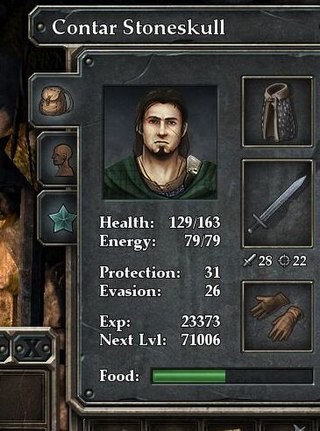
An experience point is a unit of measurement used in some tabletop role-playing games (RPGs) and role-playing video games to quantify a player character's life experience and progression through the game. Experience points are generally awarded for the completion of objectives, overcoming obstacles and opponents, and successful role-playing.

A role-playing video game, role-playing game (RPG) or computer role-playing game (CRPG) is a video game genre where the player controls the actions of a character immersed in some well-defined world, usually involving some form of character development by way of recording statistics. Many role-playing video games have origins in tabletop role-playing games and use much of the same terminology, settings, and game mechanics. Other major similarities with pen-and-paper games include developed story-telling and narrative elements, player character development, complexity, as well as replay value and immersion. The electronic medium removes the necessity for a gamemaster and increases combat resolution speed. RPGs have evolved from simple text-based console-window games into visually rich 3D experiences.
In tabletop games and video games, a character class is an occupation, profession, or role assigned to a game character to highlight and differentiate their capabilities and specializations.

In role-playing games (RPGs) and war games, a saving throw is a roll of dice used to determine whether magic, poison, or various other types of attacks are effective against a character or monster. The term was first used in Donald F. Featherstone's book "War Games".

Beyond Zork: The Coconut of Quendor is an interactive fiction video game written by Brian Moriarty and released by Infocom in 1987. It was one of the last games in the Zork series developed by Infocom. It signified a notable departure from the standard format of Infocom's earlier games which relied purely on text and puzzle-solving: among other features, Beyond Zork incorporated a crude on-screen map, the use of character statistics and levels, and RPG combat elements.
In most tabletop role-playing games (RPGs), an initiative system determines in which order player characters and non-player characters take their actions, to avoid confusion on when a character gets to act. These derive from RPGs roots in tabletop wargaming, where similar systems are used. Rules for initiative vary from game to game, but often follow one of a few common methods:

Shatterzone is a space opera role-playing game by West End Games. The game went out of print in 1997 after the company went bankrupt. The game is now back in print, owned and published by Precis Intermedia.

DC Heroes is an out-of-print superhero role-playing game set in the DC Universe and published by Mayfair Games. Other than sharing the same licensed setting, DC Heroes is unrelated to the West End Games DC Universe or the more recent Green Ronin Publishing DC Adventures game.

Role-playing games (RPGs) have developed specialized terminology. This includes both terminology used within RPGs to describe in-game concepts and terminology used to describe RPGs. Role-playing games also have specialized slang and jargon associated with them.

An attribute is a piece of data that describes to what extent a fictional character in a role-playing game possesses a specific natural, in-born characteristic common to all characters in the game. That piece of data is usually an abstract number or, in some cases, a set of dice. Some games use different terms to refer to an attribute, such as statistic, (primary) characteristic or ability. A number of role-playing games like Fate do not use attributes at all.
In the Dungeons & Dragons role-playing game, game mechanics and dice rolls determine much of what happens. These mechanics include:

Mercenaries, Spies and Private Eyes (MSPE) is a tabletop role-playing game designed and written by Michael A. Stackpole and first published in April 1983 by Blade, a division of Flying Buffalo, Inc. A second edition was later published by Sleuth Publications in 1986, but Flying Buffalo continues to distribute the game. In 2019 a new revised Combined Edition of MSPE was published by Flying Buffalo which brought the different material from the previous editions and included additional new rules and expansions to the original rpg. MSPE's mechanics are based on those of Tunnels and Trolls, with the addition of a skill system for characters. A few adventure modules were also released for MSPE.

A statistic in role-playing games is a piece of data that represents a particular aspect of a fictional character. That piece of data is usually a (unitless) integer or, in some cases, a set of dice.
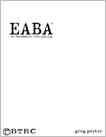
The End All Be All game system, commonly known as EABA and pronounced "ee-buh", is a role-playing game system from Blacksburg Tactical Research Center (BTRC). It is a generic gaming system designed to adapt to any imaginary gaming environment. It was created by Greg Porter in 2003. The game cites the Hero System, GURPS and Call of Cthulhu as influences in its development.

Player's Option: Skills & Powers is a supplemental sourcebook to the core rules of the second edition of the Advanced Dungeons & Dragons fantasy role-playing game.

A tabletop role-playing game, also known as a pen-and-paper role-playing game, is a kind of role-playing game (RPG) in which the participants describe their characters' actions through speech and sometimes movements. Participants determine the actions of their characters based on their characterization, and the actions succeed or fail according to a set formal system of rules and guidelines, usually involving randomization. Within the rules, players have the freedom to improvise, and their choices shape the direction and outcome of the game.

